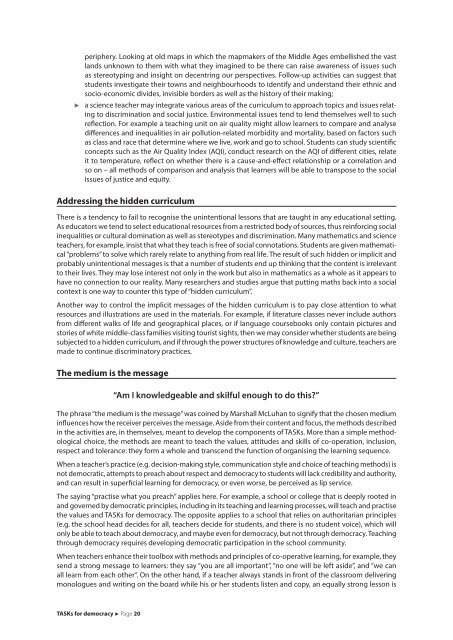TASKs for democracy
4NYw4W
4NYw4W
Create successful ePaper yourself
Turn your PDF publications into a flip-book with our unique Google optimized e-Paper software.
periphery. Looking at old maps in which the mapmakers of the Middle Ages embellished the vast<br />
lands unknown to them with what they imagined to be there can raise awareness of issues such<br />
as stereotyping and insight on decentring our perspectives. Follow-up activities can suggest that<br />
students investigate their towns and neighbourhoods to identify and understand their ethnic and<br />
socio-economic divides, invisible borders as well as the history of their making;<br />
a science teacher may integrate various areas of the curriculum to approach topics and issues relating<br />
to discrimination and social justice. Environmental issues tend to lend themselves well to such<br />
reflection. For example a teaching unit on air quality might allow learners to compare and analyse<br />
differences and inequalities in air pollution-related morbidity and mortality, based on factors such<br />
as class and race that determine where we live, work and go to school. Students can study scientific<br />
concepts such as the Air Quality Index (AQI), conduct research on the AQI of different cities, relate<br />
it to temperature, reflect on whether there is a cause-and-effect relationship or a correlation and<br />
so on – all methods of comparison and analysis that learners will be able to transpose to the social<br />
issues of justice and equity.<br />
Addressing the hidden curriculum<br />
There is a tendency to fail to recognise the unintentional lessons that are taught in any educational setting.<br />
As educators we tend to select educational resources from a restricted body of sources, thus rein<strong>for</strong>cing social<br />
inequalities or cultural domination as well as stereotypes and discrimination. Many mathematics and science<br />
teachers, <strong>for</strong> example, insist that what they teach is free of social connotations. Students are given mathematical<br />
“problems” to solve which rarely relate to anything from real life. The result of such hidden or implicit and<br />
probably unintentional messages is that a number of students end up thinking that the content is irrelevant<br />
to their lives. They may lose interest not only in the work but also in mathematics as a whole as it appears to<br />
have no connection to our reality. Many researchers and studies argue that putting maths back into a social<br />
context is one way to counter this type of “hidden curriculum”.<br />
Another way to control the implicit messages of the hidden curriculum is to pay close attention to what<br />
resources and illustrations are used in the materials. For example, if literature classes never include authors<br />
from different walks of life and geographical places, or if language coursebooks only contain pictures and<br />
stories of white middle-class families visiting tourist sights, then we may consider whether students are being<br />
subjected to a hidden curriculum, and if through the power structures of knowledge and culture, teachers are<br />
made to continue discriminatory practices.<br />
The medium is the message<br />
“Am I knowledgeable and skilful enough to do this?”<br />
The phrase “the medium is the message” was coined by Marshall McLuhan to signify that the chosen medium<br />
influences how the receiver perceives the message. Aside from their content and focus, the methods described<br />
in the activities are, in themselves, meant to develop the components of <strong>TASKs</strong>. More than a simple methodological<br />
choice, the methods are meant to teach the values, attitudes and skills of co-operation, inclusion,<br />
respect and tolerance: they <strong>for</strong>m a whole and transcend the function of organising the learning sequence.<br />
When a teacher’s practice (e.g. decision-making style, communication style and choice of teaching methods) is<br />
not democratic, attempts to preach about respect and <strong>democracy</strong> to students will lack credibility and authority,<br />
and can result in superficial learning <strong>for</strong> <strong>democracy</strong>, or even worse, be perceived as lip service.<br />
The saying “practise what you preach” applies here. For example, a school or college that is deeply rooted in<br />
and governed by democratic principles, including in its teaching and learning processes, will teach and practise<br />
the values and <strong>TASKs</strong> <strong>for</strong> <strong>democracy</strong>. The opposite applies to a school that relies on authoritarian principles<br />
(e.g. the school head decides <strong>for</strong> all, teachers decide <strong>for</strong> students, and there is no student voice), which will<br />
only be able to teach about <strong>democracy</strong>, and maybe even <strong>for</strong> <strong>democracy</strong>, but not through <strong>democracy</strong>. Teaching<br />
through <strong>democracy</strong> requires developing democratic participation in the school community.<br />
When teachers enhance their toolbox with methods and principles of co-operative learning, <strong>for</strong> example, they<br />
send a strong message to learners: they say “you are all important”, “no one will be left aside”, and “we can<br />
all learn from each other”. On the other hand, if a teacher always stands in front of the classroom delivering<br />
monologues and writing on the board while his or her students listen and copy, an equally strong lesson is<br />
<strong>TASKs</strong> <strong>for</strong> <strong>democracy</strong> Page 20


